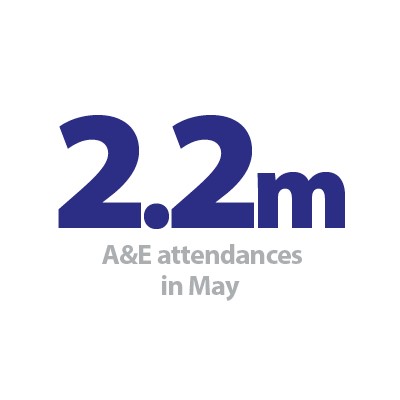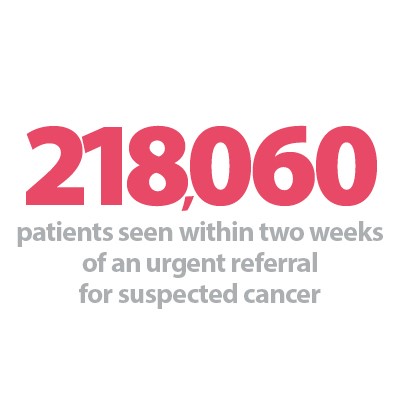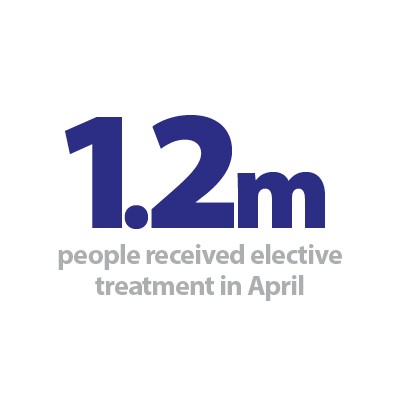


Introduction
Today, NHS England has published the latest figures for performance and activity. These statistics, as always, offer valuable insight into the pressures facing the provider sector.
These data continue to highlight the considerable achievements of trusts in their path to recovery. But they are also a reminder of the complex and challenging circumstances frontline staff are facing, with growing demand and sizeable waiting lists still prevalent, as services came out of a difficult winter and endured months of industrial action.
This month's performance figures
Each month, we look at activity and performance statistics across a range of services including urgent and emergency care, routine care, cancer, mental health and community services. Below we set out the latest trend for each clinical area.
Ambulance: May saw increases in both category 1 and category 2 incidents, with average response times also up and missing both targets.
- Ambulance category 1 incidents increased by 6% to 76,157 (4,152 more incidents). There were 2% fewer incidents compared to a year ago but incidents were 32% higher than four years ago, before the pandemic (April 2019). Ambulance category 2 incidents have also increased, by 4% to 376,292 (15,159 more incidents). Compared to four years ago, category 2 incidents were down by 2%.
- The average response time for category 1 calls increased slightly to 8 minutes 17 seconds, missing the 7-minute target. This is up from 8 minutes 7 seconds last month. The average response time for category 2 calls also increased to 32 minutes 24 seconds, up from 28 minutes 35 seconds last month and missing the 30 minutes target.
Emergency care activity: Busiest May on record, with over 2.2 million A&E attendances, representing the third highest total since records began.
- There were 2,240,070 A&E attendances, a larger number compared to the number of attendances observed the month before (10%), the third highest total since records began and the highest number for any May. There were 529,529 emergency admissions in May, a 7.9% increase on the previous month. This is also an increase of 4.5% compared to a year ago.
- Performance against the 95% target for all A&E types slightly decreased and it's now 74%, the second highest it has been since September 2021 (75.2%), right after last month's figure of 74.6%. The performance against the type 1 target slightly decreased to 60.4% this month and it's the second highest since February 2022 (60.8%).
- The number of patients waiting more than 12 hours from the decision to admit to admission has increased by 17% to 31,494 since the month before. This figure is still nearly 7,500% higher than the same month four years ago before the pandemic, when this number was 415.
Elective care: Activity has decreased across the board in April, plus the waiting list increased again and it is now at an all-time high of 7.41 million.
- The number of admitted inpatient pathways and non-admitted pathways have decreased by 21.5% and 20%, respectively, on the previous month. The number of new RTT pathways in April also decreased on the previous month from 1.9 million to 1.5 million.
- The size of the waiting list slightly increased by 1% and is now at 7,415,352 (83,378 more on the previous month). The size of the waiting list is still 68% greater than four years ago just before the pandemic.
- The number of those waiting more than 18 weeks has also slightly increased compared to the previous month (+2%). The number of those waiting more than 52 weeks increased as well and is now at 371,111 (+3%).
- However, the number of those waiting more than 104 weeks has decreased again by 6.4% to 523. The number of patients waiting more than 78 weeks has increased slightly this month by 6.9% and this figure is now at 11,477. However, this still represents a decrease of 91% since its peak in September 2021 (124,911) and a decrease of four fifths since start of 2023 (54,882 in December 2022).
Cancer: Over 218,000 patients were seen within two weeks of an urgent referral for a suspected cancer pathway. Performance against the waiting time standard deteriorated across all pathways.
- Activity across the two-week pathway has decreased by 16% since last month but is above levels seen one year ago (+7%) and above pre-pandemic levels (+10%). Over 24,000 patients completed the 31-day pathway, which aims to begin treatment within one month from the decision to treat. This is down by 18% since the last month but higher than it was one year ago (+2%) and below pre-pandemic levels (-6%).
- Over 13,000 patients completed the 62-day pathway, down by 18% from the previous month. This pathway aims to start a first cancer treatment within 62 days from an urgent GP referral. Activity for this pathway is higher than it was this time last year (+3%) but below pre-pandemic levels (2% lower than in April 2019).
- All key national targets have still not been met this month and figures have deteriorated across the board: 78% of urgent GP referrals were seen within two weeks, missing the 93% standard, 90.5% of people started treatment within one month of the decision to treat, missing the 96% target; 61% of people who started treatment did so within two months of an urgent GP referral, missing the 85% target.
Diagnostics: 2 million diagnostic tests were carried out in April and the diagnostic waiting list has reduced this month, even though it remains high at over 1.56 million.
- 2 million diagnostic tests were carried out, a decrease of 12% from the month before. However, activity for the latest month is 9% higher than one year ago (165,311 more tests) and is 5.2% higher than pre-pandemic levels, with 98,892 more tests carried out compared to April 2019.
- The number of MRI, CT scans and colonoscopies have all decreased compared to last month, down by 8.3%, 9.6% and 15.1% respectively. However, activity is higher than the same time last year for all these three tests and is also above pre-pandemic levels, up by 14%, 23% and 16% respectively.
- The diagnostic waiting list has reduced this month but remains high at 1,563,392. This is 4% lower than in March but 1% higher than April last year. Compared to April 2019 before the pandemic, the waiting list has grown by 48%.
- The number of patients waiting six weeks or more for a test is at 27.6%; this is up from the month before (25%) and is still missing the 1% target.
Discharge delays:
- On 31 May (a Wednesday) there were 22,588 patients who no longer met the criteria to reside in hospital. Of these, 53% remained in hospital on that day (11,946).
- For the month of May, there were an average of 22,296 patients who no longer met the criteria to reside. Of these, an average of 12,597 (56.5%) patients remained in hospital. This is lower than the month before (57.5%) but remains high.
Community services:
- In April 2023 the total reported waiting list in England was 940,603. This is 1% lower than the previous month but 3% higher than October 2022, when the data collection started. 715,446 of these relate to adult services, a decrease of 1.5% from March but 1.6% higher than October 2022. 225,157 of these relate to children and young people's (CYP) services, down from the month before (-1%) but 9% higher than October 2022.
- For adult services, 101,169 people have been waiting 18-52 weeks for treatment, this has decreased from the month before (-6%) and accounts for 14% of the total adult waiting list. There are 12,174 people who have been waiting over 52 weeks, lower than the previous month (-7%), accounting for 1.7% of the adult waiting list. For CYP services, 68,831 have been waiting 18-52 weeks (1% more than in March), making up 31% of the total CYP waiting list. There are 14,782 CYP who have been waiting over 52 weeks, up from the last month (+8.1%), accounting for 6.6% of the CYP waiting list.
Mental health: Caution should be taken when interpreting these figures due to the recent cyber incident. However, impact on the following data is understood to be limited.
- In March 2023, there were 469,770 mental health referrals. This is up by 15% compared to the previous month and 10% compared to a year ago. Compared to pre-pandemic levels (March 2020), referrals are up by 58%.
- There were 167,407 referrals to talking therapies in March 2023. This is up by 13% since the previous month (18,738 more). Compared to a year ago, referrals are up by 1% and up considerably by 54% compared to three years ago (March 2020).
- In March 2023, there were 760 out of area placements, 30 fewer out of area placements (OAPs) than the previous month. Compared to a year ago, there are 90 more OAPs. Compared to pre-pandemic levels, this is up by 34% (195 more than March 2020).
- In March 2023, 90% of referrals that finished a course of treatment in the month, accessed IAPT within 6 weeks, a similar proportion to the one registered in February 2023.
Our view
The data published this month continue to show a challenging picture with a number of different demand and activity trends. They also continue to highlight the pressure being felt by overstretched services.
May, which saw a larger number of bank holidays this year, was particularly busy for the urgent care pathway, with the number of A&E attendances reaching a record high for any month of May, and the third highest figure since records began. Equally, ambulance activity increased, with the number of category 1 and category 2 incidents climbing up.
Even though demand for elective care continues to be felt, and the overall waiting list is now over 7.41 million, trusts have been making remarkable progress in elective recovery over the last few months. These achievements were particularly evident in cuts to waiting times, all against the backdrop of the most severe winter pressures to date, workforce shortages and a series of strikes never seen before in NHS history. April also saw 2 million diagnostic tests carried out, with MRIs, CT scans and colonoscopy activity being above pre-pandemic levels, as well as a reduction in the overall waiting list which is now at over 1.56 million.
That said, these achievements are not enough to keep up with demand, and system-wide issues across the health and care sectors continue to have an impact on services, as evidenced once more by the large proportion of medically fit patients remaining in hospital, meaning patients are not moving easily through the system.
Once again, the urgent need for a fully funded workforce plan that will address the scale of these demand pressures is unmistakably evident in today's figures, as we see the NHS continuing to try to recover and transform, while struggling to keep up with growing demand.
Gastro transformation reducing waiting times
Dr Matt Warren, consultant gastroenterologist at Northumbria Healthcare NHS Foundation Trust (Northumbria Healthcare) discusses how the trust has reduced waiting times for gastroenterology patients.
Northumbria Healthcare has slashed treatment waiting times for gastroenterology (GI) patients in a move that could be replicated in other parts of the NHS to help reduce the time people spend on waiting lists.
Hospital consultants in Northumberland and North Tyneside have reduced the waiting times for GI outpatients by offering rapid reviews of GP referrals, with senior specialist management advice and rapid access to clinic appointments. Across the NHS, large waiting lists for hospital outpatient appointments have built up for patients referred to see hospital consultants and as a result they can sometimes wait weeks or months before seeing a doctor in hospital.
So far, the changes at Northumbria have led to a significant reduction in waiting times for routine GI outpatient appointments – down from four months to less than four weeks. The team can also provide advice to GPs around the investigation and treatment of those patients who can be managed in primary care within 48-72 hours. At the same time, there has been a significant increase in the number of GP referrals into GI services.
The GI department at Northumbria treats a wide range of conditions relating to the liver and digestive tract (this is the gullet, stomach and bowel). This includes common problems such as ulcers, heartburn and change of bowel habit but also more complex conditions or long-term illnesses such as chronic liver disease and inflammatory bowel disease.
Consultants in Northumbria Healthcare have worked on delivering rapid specialist advice and treatment plans to patients, aiming to offer support to GPs to manage suitable patients in the community, but also freeing hospital clinic appointments to see patients much more quickly when needed.
This frontline senior review and referral triage also ensures that patients can also be referred directly to receive diagnostic tests such as endoscopy when needed, as well as ensuring that patients who require outpatient review are seen by the right clinical team first time.
Traditionally patients have waited for an appointment at a hospital outpatient department to get advice about their condition, but we felt that consultants could offer a better and more rapid service by adapting this model and offering treatment and expert advice in a more flexible and individualised way.
By moving to an advice and guidance model in selected and appropriate cases, we were able to offer very quick advice to GPs within days, rather than patients having to wait weeks or even months for an outpatient appointment that would have resulted in the same tests or treatments. This has freed up some outpatient clinic capacity and now if a GP sees a patient that they are particularly concerned about we are able to offer very rapid outpatient review, far more responsive and flexible than under our previous system.
To help improve the service the team has:
- Worked with GPs in shared learning events to discuss common GI conditions.
- Championed an advice and guidance service to offer rapid specialist advice for GPs to support them in the care of patients who do not require urgent hospital appointments.
- Ensured that primary care views are heard by delivering a survey of local GPs.
- Worked to ensure that advice given to GPs is helpful and collaborative, for the benefit of the patients rather than an administrative or gatekeeper process.
It is hoped that some of the improvements delivered by Northumbria Gastroenterology and the lessons learned in the process may be replicated or adopted by other parts of the NHS as part of elective recovery and will help to speed up access to specialist advice and treatment, reduce waiting lists and ultimately improve the health of the population.
A&E


Cancer


RTT


Diagnostics


Ambulance


Mental health

